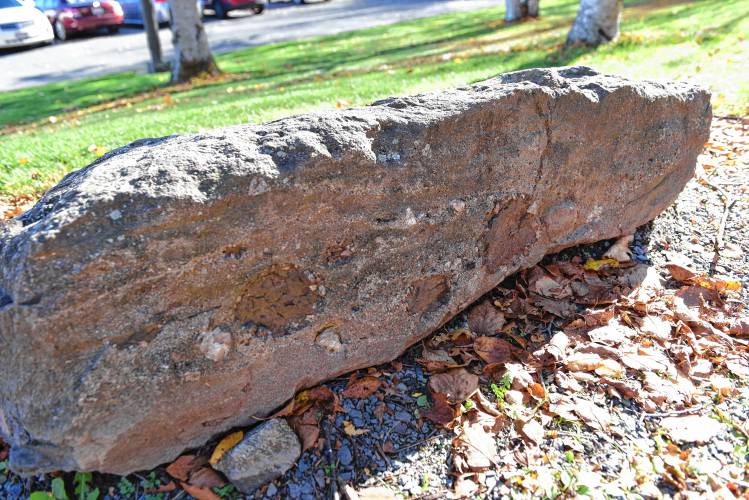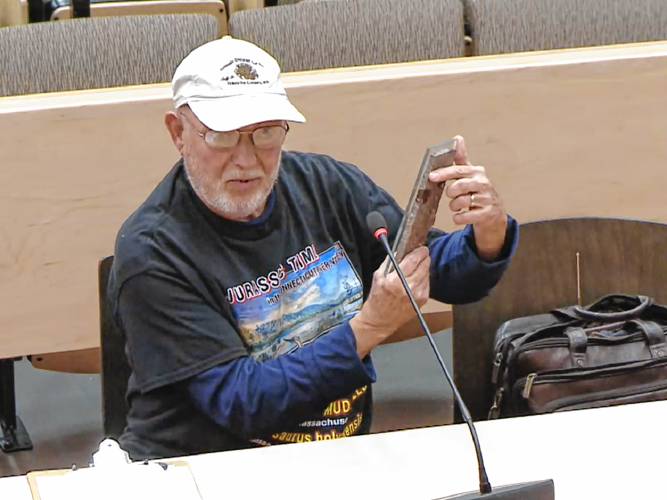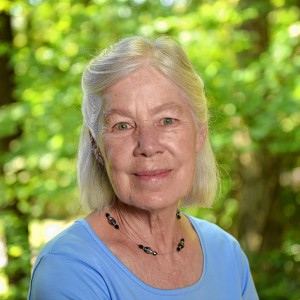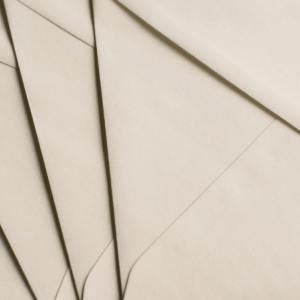My Turn: GCC and the rare Jurassic armored mud balls
| Published: 03-31-2025 2:25 PM |
Did you know Greenfield Community College has the best-in-the-world examples of armored mud balls, one of the rarest geologic features? These 200-million-year-old (Jurassic Period) treasures are displayed in the college’s “Geology Path,” a short path with rocks recording a half-billion years of our region’s dramatic geologic history (https://www.gcc.mass.edu/oll/geology-path). The Geology Path’s distinctive “JAMB” specimens are in quarried sandstone blocks containing balls from basketball to golf ball sizes, all rimmed with distinct pebble “armor.”
Imagine a Jurassic thunderstorm that generated a flash flood. Mud stream banks eroded. Pieces fell into the rushing current becoming round and coated (armored) with streambed pebbles. As the flood subsided, these delicate sedimentary structures were buried in sandy sediment, protecting them from drying and disintegrating. With deeper burial and geologic time, the layers lithified, becoming solid rock. In Jurassic times, the Connecticut River Valley area was part of a large rift valley, much like Death Valley today. Conditions were just right with mud, floods, and sediment to form and preserve these rare structures in the bedrock of Turners Falls, Gill, Greenfield and Deerfield.
Greenfield Community College is an important part of the JAMB story. As a new faculty member, five decades ago, I visited the Connecticut River at Unity Park, Turners Falls and observed two roadside foundations built with quarried local sandstone. The foundations were the cable anchors of an historic suspension bridge (1878 – 1942) connecting Turners Falls and Gill. Many of the reddish stones had round dark shapes mixed in with the sand and pebbles composing the rock. The round shapes were armored mud balls. Lithified armored mud balls are extremely rare and had never been previously discovered in our region. I became the first to document them (Journal of Geology, 1982) and it is jokingly said: “JAMBs less than 2 inches are the ‘Little’ Armored Mud Balls.”
With the town’s approval, the foundation stones containing JAMBs were transported to GCC and are a prominent part of our Geology Path. Some smaller pieces are in a hallway display near room N350. GCC is a wonderful repository for the preservation and display of these rare and unique features. With our focus on community and education, the JAMBs have an important role to play, celebrating the unique deep history of our region. Everyone who sees and learns about the JAMBs smiles! It is science, history, education, and fun.
The JAMBs need to be more than a local phenomenon! Bills in the Legislature (H.3438 and S.2115) designate Jurassic Armored Mud Balls as our “State Sedimentary Structure.” I urge everyone’s support since official recognition will ensure these rare and amusing features will not be forgotten. Geologists confirm: Jurassic Armored Mud Balls (JAMBs), one of the world’s rarest sedimentary structures, represent a unique geology only easily seen in Massachusetts. That alone makes our JAMBs worthy of recognition.* (S. Mabee, retired &; B. Yellen, Mass. State Geologists)
Richard D. Little, is a professor emeritus at Greenfield Community College. For questions, comments or for legislation promotion materials, please contact Prof. Little at ArmoredMudBall@gmail.com, or (413) 527-8536. For more informatiopn online, visit: https://ArmoredMudBalls.rocks.



 From Global to Local: Resistance is alive and well
From Global to Local: Resistance is alive and well Pushback: The growing crowd next door
Pushback: The growing crowd next door Mike Naughton: Gerrymandering not the answer
Mike Naughton: Gerrymandering not the answer Nelson Shifflett: Lead and we will follow
Nelson Shifflett: Lead and we will follow
